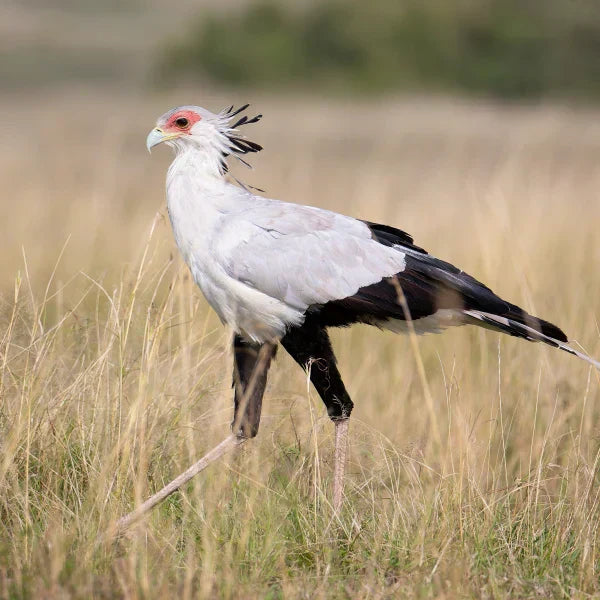Introduction
Don't be fooled by the pencil-skirted walk and fiery eyelashes. The secretary bird isn't here to grab coffee or take minutes. With spear-like legs and powerful kicks, this bird struts down the African grassland like a supermodel on a runway. But when it strikes, it does so with the precision of a karate expert.
But how did this odd-looking raptor earn such a strange name? Why does it walk more than it flies? And what makes it one of the most captivating birds of prey on the planet? In this article, we'll explore these questions in depth.

What's With the Name?
Why name a bird that kills cobras a "secretary"? The reason is a mix of fashion and folklore. In the 1800s, European naturalists noticed the bird's black crest plumes. They thought they resembled quill pens that clerks used to tuck behind their ears.
However, the name may have even older roots. Other historians suggest that it comes from the Arabic phrase "saqr-et-tair, "or "hunter bird." The term was later altered through colonial influences to become the Dutch word "secretaris." Both are plausible and highlight the bird's unique appearance and lethal prowess.

Photo by James Lee by Pexels
In various African cultures, the bird holds symbolic significance. For the Tsonga, it is known as Mampfana. With its wings outstretched, it stands tall on South Africa's coat of arms. They represent accent, vigilance, and natural protection.
Taxonomically, the Secretary Bird is unique, as they are the sole member of the family Sagittariidae. Its scientific name, Sagittarius serpentarius, translates to "archer of snakes." Whether seen as a clerk, a warrior, or a guardian, the Secretary Bird embodies every aspect that its name suggests.

By Echando una mano, via Wikimedia Commons, licensed under CC BY-SA 4.0.
Anatomy of a Snake Hunter
Reaching a height of up to 1.3 meters, their kill rate is largely due to their long, stilt-like legs. These towering legs elevate its body above the grass, providing a clear view of potential prey underneath. However, vision is only the beginning. Each leg is covered in thick, keratinized scales. These scales provide crucial protection against venomous snake bites.
Complementing its lethal footwork is a head that's made for precision. A hooked beak is ideal for tearing flesh, and forward-facing eyes provide excellent binocular vision. Additionally, the Secretary Bird has a crest made of over 20 slender black feathers that arch back. Originally thought to be quills, these feathers may serve purposes, such as camouflage, signaling, or threat display.
The Secretary Bird’s hunting abilities are linked to its unique anatomy, much like the specialized beak of the Shoebill. Curious how it works? Read more in our article on the Shoebill Stork: Bird Named For Its Beak Shape.
Life in the Savannah
The secretary bird is indeed the true child of the African sun. It can be found across Sub-Saharan Africa, from Senegal and Ethiopia in the north to South Africa. Wherever huge open spaces exist, you will likely find this long-legged predator striding across the grass. It likes open savannas, dry plains, and thinly wooded scrublands. In these areas, the low cover enables them to spot snakes, lizards, and rodents.
Unlike most raptors, the secretary bird stalks its prey on foot, sometimes covering up to 30 kilometres a day. It strides in measured grace, head down, eyes alert, thinking carefully about each step. This poised walk is not suited to dense forests or marshes. When it's trying to catch the sly snakes and lizards hiding in the grass, the shadow cast by the flight is like a warning bell. It’s only by creeping low to the ground that the secretary bird can launch that fatal kick with deadly accuracy.

Diet and Hunting Behavior
The secretary bird not only kills snakes, but does so with remarkable precision. Thanks to a hinge-like intertarsal joint, the bird can deliver explosive downward force. Their kick can reach up to 195 Newtons in less than half a second, quicker than the blink of an eye. Unlike most raptors, their toes do not have hooked talons. Instead, they are blunt and straight, which makes them ineffective at grasping, but ideal for trampling.

Its hunting method is a combination of ambush and endurance. It walks smoothly, eye vigilant, until it senses movement; then it freezes and strikes with deadly precision. Their prey includes some of Africa's deadliest snakes, such as boomslangs, puff adders, and cobras. Though bites do happen, the bird's armoured scales on its legs and agile footwork help keep it safe.
Snakes are only part of the Secretary bird's diet. As opportunistic predators, they have a broad range of tastes. They feed on insects like beetles, grasshoppers, rodents, small birds, lizards, and even juvenile tortoises.
Breeding, Parenting, and Social Life
Secretary birds are primarily monogamous, with strong pair bonds that can last for years. Once mated, a pair defends and patrols a shared territory, season after season, returning to the same nest each year. Couple mates fly in wide arcs, perform synchronised spirals, and even lock talons in mid-air before plummeting in awe-inspiring free-falls.

Nesting and Raising Chicks
As the sun begins to set, the Secretary Bird shifts its priority to safety. Secretary Birds nest high in trees, particularly in flat-topped acacia or thorn trees. They construct massive stick nests several metres above ground level. These elevated refuges are secure from predator attack on the ground. They also serve as high vantage points for early morning reconnaissance. Each year, they reuse the same nest, adding more sticks to it. The building structures can be as wide as 2.5 meters. A fitting home for a bird that walks, stalks prey, and rules the savannah.
The female lays two to three eggs. Although often one chick will outcompete its sibling for food and space, leading to the sibling's death. Both parents share the responsibilities of feeding, guarding, and shading the developing chick. The growth of chicks is fast. They feather quickly and fledge in 60 to 100 days, ready to begin their long-legged journey as ground-stalking predators.

Behavior and Personality
Secretary birds spend most of their time alone or with a mate, gliding quietly over the grasslands in synchronized steps. They are territorial birds and will not think twice about defending what is theirs. Showdowns are theatrical. They involve aerial chases, honking, wing flaring, and sudden flare of crest feathers. Their personality varies with the situation. Some birds retreat into the scrub when threatened, while others stand upright when threatened.
Although not songbirds, Secretary Birds possess their own coded language. Their clucks, croaks, hisses, and low-hooted calls are subdued but meaningful, often used between mates or when handling young. However, they rely primarily on visual signals for communication.

By Stephen Temple, via Wikimedia Commons, licensed under CC BY-SA 2.0.
Conservation Efforts
The secretary bird may stride with confidence, but its future is far less certain. Once common across sub-Saharan Africa, it's now listed as Vulnerable due to the IUCN Red List. Some populations are experiencing declines of over 70%. Its decline is largely due to human activity, such as habitat loss and urbanization.
Today, threats come in more subtle forms, such as pesticides, rodenticides, and poisoned carcasses. Some are mistakenly shot or trapped, as their menacing appearance can be misinterpreted as dangerous.
But all hope is not lost. Some organizations, such as BirdLife International, the Endangered Wildlife Trust, and African Raptors Conservation, are leading targeted efforts. These include habitat restoration, pushing for protective laws, and educating communities. Also, community outreach in Kenya, Botswana, and South Africa connects traditional land use with raptor-friendly practices. With the aim of promoting harmonious coexistence between humans and raptors.

Conclusion
The secretary bird is one of those creatures that makes you stop in your tracks and look twice, not because of their appearance, but for what it does. With every calculated step and bone-crushing kick, the secretary bird keeps the peace in the wild. They keep snakes, rodents, and chaos in check on the plains. It's a bird of contradiction: sleek as a hawk, and graceful as a crane. Unfortunately, as with many wild animals, their habitat is shrinking. As grasslands shrink and threats increase, protecting this bird means preserving a whole way of life on the savannah. If we want wild places to stay wild, then this long-legged killer deserves our support.
In contrast, due to its unique appearance, the marabou stork is often mistaken for a symbol of a 'bad omen'. However, like the secretarybird, it plays a crucial role in the African ecosystem. To learn more about this misunderstood bird, check out our article: The Marabou Stork: Africa’s Most Misunderstood Bird.

FAQs about the Secretary Birds
Are secretary birds really relatives of eagles?
Yes, they are! Despite their extremely different appearance, secretary birds are raptors and belong to the order Accipitriformes, which also includes hawks and eagles. They are the only members of the family Sagittariidae. However, they split from other raptors around 33 million years ago. This makes them evolutionary orphans with no close living relatives.
Can secretary birds fly with such long legs?
Absolutely! Those lengthy legs do not hinder their ability to fly. They have a powerful, 2.1-meter wingspan and can rapidly launch themselves into the air if they need to. However, flying is energy-intensive. So, they would prefer to walk long distances daily across grasslands, using their long strides to cover up to 30 km a day while foraging for prey.
Why are they called secretary birds?
Secretary birds are named for their resemblance to 19th-century secretaries. Their distinctive crest of long, black feathers at the back of their head is thought to resemble the quill pens that secretaries of that era would tuck behind their ears.
Do secretary birds really have eyelashes?
Yes, in a way! Their "lashes" are actually modified feathers that shield their eyes from the sun, dust, and impact when hunting.
Where are Secretary Birds in popular culture?
Secretary Birds have inspired characters like Pokémon's Blaziken. They also appear in African myths and children's television shows, such as The Lion Guard.





Leave a comment
All comments are moderated before being published.
This site is protected by hCaptcha and the hCaptcha Privacy Policy and Terms of Service apply.